
by Terri Cook Wednesday, March 15, 2017
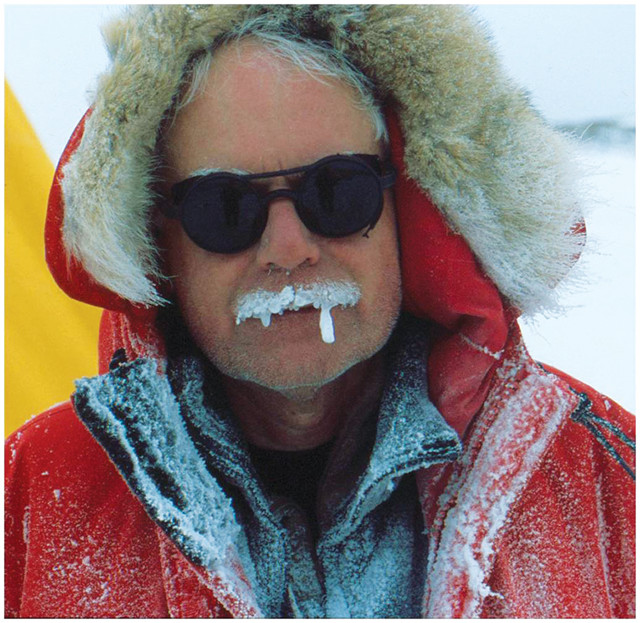
James W. Head III, shown here in Antarctica, is the Louis and Elizabeth Scherck Distinguished Professor of Geological Sciences at Brown University in Providence, R.I. Credit: Dave Marchant.
In the late 1960s, as James W. Head III was finishing his graduate degree in geology at Brown University in Providence, R.I., he decided one day to take a look at a college placement annual, a phone book-like publication that listed prospective employers according to the types of jobs they had available. When Head looked up geology in the index, he saw several consecutive pages of related listings, as well as one separate page number. Curious about the outlier, Head flipped to it — and never looked back. Covering that entire page was a photo of the moon, a D.C.-area phone number, and a single line of text: “Our job is to think our way to the moon and back.”
Intrigued, Head called the number and learned that the advertiser was Bellcomm, Inc., an organization carved from Bell Labs earlier that decade to provide technical advice to NASA’s Apollo space program. Although he had already applied for positions in academia and the oil industry, Head leapt at the chance to interview at the lab. Despite his fears that he might not be qualified, he was quickly hired.
The job was a complete departure from the traditional geologic mapping that Head had worked on since his undergraduate days at Washington and Lee University in Lexington, Va. While at Bellcomm, he helped select Apollo landing sites and train NASA astronauts in geology. Although he only worked there for four years, the experience set the stage for his entire career.
In 1972, Head accepted an academic position back at Brown, where he still works today. His research has focused on applying studies of fundamental Earth processes to understanding the geologic history of the moon, Mars and other planets, as well as harnessing those insights to decipher the still-missing chapters in Earth’s early history. Head has received numerous awards for his pioneering research, including the Penrose Medal, the Geological Society of America’s highest honor, in 2015; the American Geophysical Union’s 2013 N.L. Bowen Award; and the NASA Lunar Science Institute’s 2016 Shoemaker Distinguished Lunar Scientist Medal. He was also recently elected to the Russian Academy of Sciences for his collaborative efforts over the last 40 years with the Soviet and Russian space program.
Head recently spoke with EARTH about what he learned from working with the Apollo astronauts; the concept of systems engineering and how it has enhanced his research program; and the relationship between art and science.
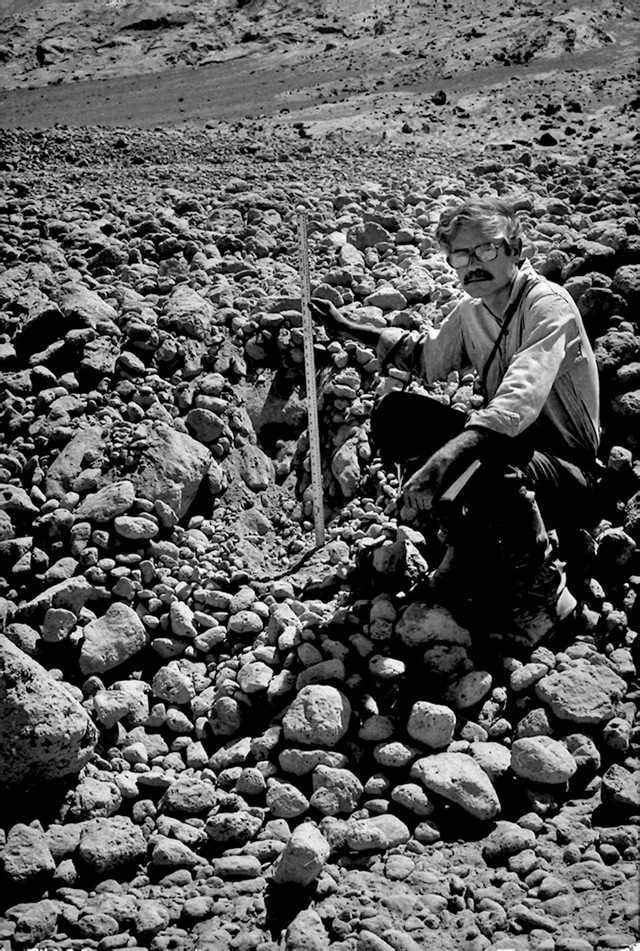
Head studying the margin of a pyroclastic flow emplaced days before by an eruption from Mount St. Helens in June 1980. Credit: Lionel Wilson.
TC: How did you become interested in field geology?
JH: As a kid, I really liked the outdoors. So when I had to fill a science distribution requirement as an undergraduate at Washington and Lee, I chose geology because the labs were outdoors. It was a real epiphany. Then one day toward the end of the semester, the professor announced that he needed a field assistant in Montana that summer and anyone who was interested should talk to him after class. I always sat in the back to see the beautiful slides, so I thought I’d never get down there in time to even be in the line. When the class ended, I raced down — I probably knocked a couple people over. But I was the only one who went up, and I got the job. Just before I drove away in the field vehicle, my professor told me that I’d either come back loving geology, or hating it. Of course, that experience was phenomenal, and I came back loving it. I was lucky enough to work the rest of my college summers in the field mapping the Appalachians.
TC: Why did you shift your focus to planetary geology?
JH: By the time I got to graduate school, my interest had turned to carbonate deposition in shallow marine environments. I was well on a path toward teaching at a small college or going to work for the oil industry. But during that period, one of my advisors, Tim [Thomas] Mutch, became interested in planets. One day during a stratigraphy and sedimentation seminar, he walked over to the window, looked out, and stopped talking for a couple of minutes. Then he turned around and said, “There are no fundamental problems left in Earth stratigraphy. What we need to do is take all the techniques we have at hand and use them to try to figure out how to map the other planets.”
Here I was, almost ready to go off and get a job in that very field! The other students and I all thought this was wacko, but we did what he proposed. We took the complete electromagnetic spectrum, from radio to gamma rays, and looked at how you could apply that to Earth and then how those same techniques could be used to learn something about other planetary bodies, which was completely revolutionary and very, very insightful.
TC: Why did you go to work for Bellcomm instead of NASA?
JH: Bellcomm was the systems engineering division of NASA headquarters. At that time, the telephone company had incredible cutting-edge technological labs where things like transistors were discovered. So whenever the government had a problem that they needed a bunch of bright people to solve, they went to one of those labs. For the Apollo program, the government asked Bell Labs to be the systems engineering organization because Bell already had a system in place to organize and coordinate things, and it was completely integrated into the whole NASA system. While there I worked on [moon landing] site selection, traverse planning, astronaut training and mission operations.
TC: Was it ever a problem that you lacked a relevant background?
JH: For the first year, I worried that people would find out that my thesis was on shallow marine carbonate deposition and would laugh me out of the program. But slowly I realized that no one had any real background because it hadn’t been done before. I’ve heard that geologists were some of those who were best able to predict where the German U-boats would intercept convoys in World War I, presumably because of our integrative background. You learned as you went, and I came to understand that my interest in putting details into a broad framework was a great background for the job. It was intense: When I walked in the door the first day, my first assignment was to prepare briefings for Congress on future Apollo landing sites.
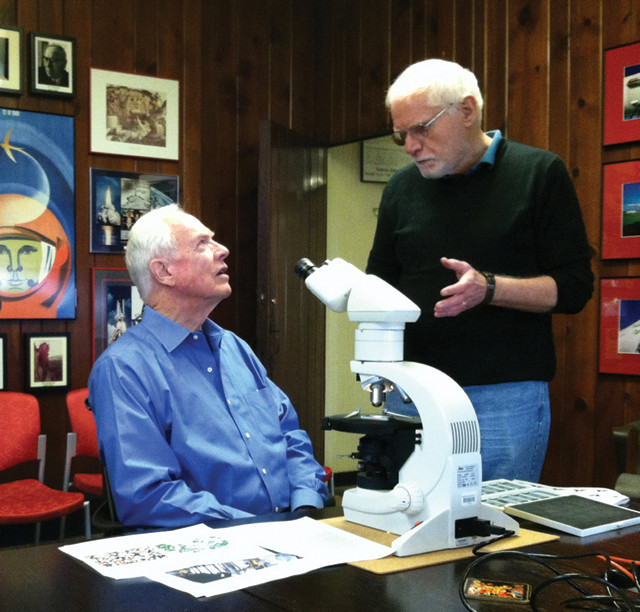
Head and Apollo 15 Commander Dave Scott discussing thin sections of lunar samples Scott collected at Hadley-Apennine, the landing site for Apollo 15. Credit: Peter Neivert.
TC: How long did you have to prepare for the briefing?
JH: About a week. It was pedal to the metal. When I was in China recently, a colleague asked me what it was like being in competition with the Soviets [during] the space race. I can’t remember a single day when we sat around and talked about what the Soviets were doing. It was all about accomplishing President Kennedy’s challenge: the unbelievable feat of getting humans to the moon and safely returning them. Competitions and negative comments were all just put aside. And if you had something worthwhile to say, you were encouraged to say it. You were part of the team from the get-go. It was exhilarating.
TC: What is systems engineering and how has it helped you in planning your research?
JH: It’s thinking about the process and all of its components from the beginning to the end. At NASA, as we prepared each mission, we had to think about the landing site, the traverses, and the observations and rock sampling. Each step of the way, we had to come up with new ways of doing things because none of it had ever been done before.
With my research, I tend to take a systems analysis approach to problems: What’s the question, how do we get the answer and what do we have to do to get there? I think about how I can contribute, what approaches to take, and whether there are other people with whom collaborations might be useful. That’s been really important because, as I saw at NASA, if you get the right people working together, it’s totally synergistic.
TC: Many senior researchers don’t teach undergraduate courses. Why do you?
JH: I really enjoy teaching introductory classes because you learn so much from your students. It’s supposed to be the other way around. But sometimes, students will ask you these “fasten-your-seat-belt” questions that you haven’t really thought about, so it’s great fun. Plus, it’s great preparation for research to be able to explain to someone with no background what the problems are. It helps me align my thoughts and realize what I do, and don’t, know.
TC: What does the future hold for you?"
JH: The future is all about human and robotic partnerships in exploration. My group is preparing for future missions, including helping to choose landing sites on Mars for robotic exploration in 2020 and human exploration in the 2030s. Our landing site for the human exploration mission is really interesting; it’s in the midlatitudes where there are debris-covered glaciers like we’ve worked on in Antarctica. You can get down to really pure ice very rapidly. I’m heading up an international group to analyze these sites, and Apollo 15 Commander Dave Scott is one of the team members. That’s important because he’s had the experience of actually going to another planetary body. Andy Weir [author of “The Martian”] is also on our team.
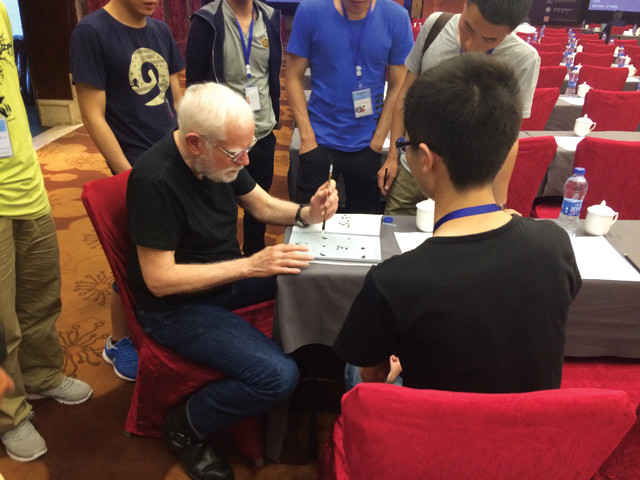
Chinese graduate students teaching Head Chinese calligraphy in Wuhan, China. Credit: Courtesy of James W. Head III.
TC: You’ve worked on several outreach projects combining art and science. Do you feel the exploration of the sola" system is an artistic, as well as a scientific, endeavo"?"
JH: Totally! No one can look at images from space and not be awed. I recently gave a presentation where I projected slides of the planets while the Brown University Orchestra performed Holst’s “The Planets.” It was a blast; we packed the place! I also gave a science-art symposium called “Postcards From Other Planets” where I projected about 50 different images of the surface of Mars and just let them sit for 10 seconds each to display their remarkable beauty. My plan was to give a bit of context at the beginning and the end, but to just let the slides flow in between. But of course, being a scientist, as these images were flashing across the screen, I couldn’t help but take my pointer and start pointing out details, like a sand dune. At the end, when I asked my wife Anne, who is an artist, how I did, she said it was fine, but that I needed to “lose the pointer” because it was totally distracting to artists.
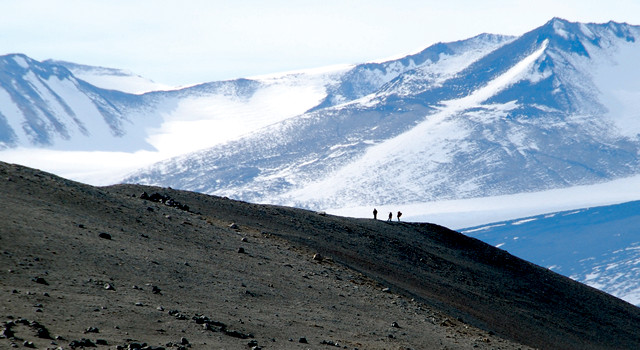
Head traversing the Upper Wright Valley in Antarctica with colleagues Laura Kerber and Jay Dickson. Credit: Mark Salvatore.
TC: What are some of your interests and hobbies?
JH: I very much enjoy the study of “inner space,” of how the brain and body work. I am fascinated with how the human mind has evolved in our attempts to understand the natural world, and how things like magic, superstition and religion have tried to fill the gaps in rational understanding. I also like traveling, and the new perspectives and insights I gain from seeing things with new eyes. I am a great believer that the only constant is change, and I enjoy being a part of that, be it exploring planets or watching the seismic cultural shifts that are brought about by new technology.
© 2008-2021. All rights reserved. Any copying, redistribution or retransmission of any of the contents of this service without the expressed written permission of the American Geosciences Institute is expressly prohibited. Click here for all copyright requests.